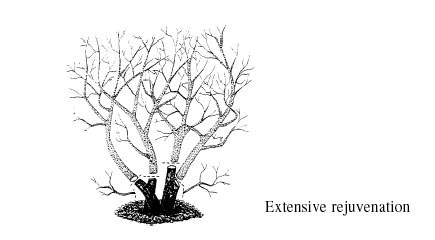Rejuvenation Pruning: Strong Medicine for Old Plants
By Gil Medeiros
Has that old forsythia shrub near your foundation seen better days? Is it too big? Does it have dead branches? Are you thinking of getting rid of it? Here’s another option: You may want to cut it back to the ground, and let it sprout anew using a technique called rejuvenation pruning.
 Be careful because rejuvenation pruning won’t work for every shrub. For example, it doesn’t work at all for evergreen shrubs. It will likely kill those plants. That old forsythia will not survive either, if the plant is not healthy. As a rule of thumb, if more than a third of the shrub is dead, it is unlikely to survive rejuvenation pruning. Replacement is a better option.
Be careful because rejuvenation pruning won’t work for every shrub. For example, it doesn’t work at all for evergreen shrubs. It will likely kill those plants. That old forsythia will not survive either, if the plant is not healthy. As a rule of thumb, if more than a third of the shrub is dead, it is unlikely to survive rejuvenation pruning. Replacement is a better option.
You can do rejuvenation pruning successfully on tartarian and red-stemmed dogwood, forsythia, rose of Sharon, hydrangea, privet, honeysuckle, elderberry, spirea and lilac. You can do rejuvenation pruning annually on butterfly bush, usually in March in Fairfax County.
The process is very simple. In late winter, before buds have broken, use loppers or a pruning saw to take down the entire shrub, leaving behind only about 12 inches. Since you are removing all of the plant’s stored resources, except for sugars in the roots, it is wise to fertilize and water this plant as it regrows. Expect it to regrow many new shoots. Be prepared to thin them in order to reduce internal competition and to produce a pleasing shape.
In a year or two, your shrub should look like new. Also as an alternative, consider the less risky cousin of rejuvenation pruning — renewal pruning.
References
A Guide to Successful Pruning, VCE Publication 430-459, Pruning Shrubs, 2009
Hacking and Whacking–Dealing with Overgrown Shrubs, Penn State Extension Publication, 2012
Pruning Flowering Shrubs, Colorado State University Extension Publication Garden Notes #616